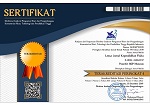Pembuatan Kitosan dari Cangkang Udang sebagai Adsorben Emas (Au)
DOI:
https://doi.org/10.33394/j-lkf.v5i2.140Keywords:
Shrimp shells, Adsorbents, ChitosanAbstract
[Title: Making Chitosan From Shrimp Cup As Gold (Au) Adsorben]. This study aims to make chitosan from shrimp shell as golden adsorbent. Stages of chitosan preparation include demineralization stage using 1,5M HCL, deproteination stage using 3.5% NaOH to obtain chitin powder, then followed by chitin deacetylation stage using 60% NaOH to produce an anime that is chitosan. Subsequently, the chitosan obtained was characterized, analyzed functional group with FTIR and determined its adsorption capacity against Au metal ion, Au content in the sample before and after adsorption was measured using AAS. The results showed chitosan characterization as follows: rendeman 45.83%, have powder texture, white colour, odourless, have moisture content 1.55%, perfectly soluble in glacial acetic acid 2% and purple positive with ninhydrin solution showed chitin has turned into chitosan. Based on calculations from the results of the resulting chitosan FTIR data has a degree of deacetylation 71.17%. From the result of analysis by using AAS that chitosan obtained able to adsorb Au metal from concentration 8.55 ppm decrease until 5,09 ppm with adsorption percentage equal to 40.46%.References
Agustina Sry. 2013. Pembuatan kitosan dari cangkang udang dan Aplikasinya sebagai Adsorben untuk menurunkan Kadar logam Cu. Skiripsi. IKIP Mataram.
Hargono dan Djaeni, M. 2003. Pemanfaatan Khitosan dari Kulit Udang sebagai Pelarut Lemak. Prosiding Teknik Kimia Indonesia. Yogyakarta.
Herdyastuti, N., T.J. Raharjo, Mudasir dan S. Matjeh. 2009. Chitinase and chitinolytic microorganism: isolation characterization and potential. Indonesian Journal of Chemistry. 2009.9(1): 37-47.
Junarto Ekho gotot. 2015. Menghitung Derajat Deasetilasi (online). http://kehidupangdotkong.blogspot.co.id/2015/10/menghitung-derajat-deasetilasi.html, diakses tanggal 25 Agustus 2017 Pukul 14.27 p.m
Kusumaningsih, Triana, dkk. 2004. Pembuatan Kitosan dari Kitin Cangkang Bekicot. Jurnal Biofarmasi 2(2):64-68, Agustus 2004, ISSN: 1693-2242. Surakarta: UNS.
Ogawa, et al. 2004. Three D Structures Of Chitosan. International Journal Of Biological Macromolecules, Vol. 34, pp.1-8
Puspawati, N. M, et al. 2010. Opimasi Deasetilasi Khitin dari Kulit Udang dan Cangkang Kepiting Limbah Restoran Seafood menjadi Khitosan melalui Variasi Konsentrasi NaOH. Jurnal Kimia 4 (1), Januari 2010,70-90, ISSN 1907-9850.
Rachmania, Desie. 2011. Karakteristik Nano Kitosan Cangkang Udang Vannamei (Litopenaeus vannamei) dengan Metode Gelasi Ionik. Skripsi. Bogor: IPB
Sudarmaji, dkk. 1994. Prosedur Analisa Untuk Bahan Makanan dan Pertanian. Yogyakarta: Liberty.
Tao Lee, S, dkk. 2001. Equilibrium and Kinetic Studies Of Copper(II) Ion Uptake by Chitosan-tripolyphosghate Cheleating Resin. Polimer 42: 1879-1892.
Zahiruddin, dkk. 2008. Karakteristik Mutu dan Kelarutan Kitosan dari Ampas silase kepala udang windu (Panaeus monodon). Buletin teknologi hasil perikanan Vol.11 No. 2. IPB.
Downloads
Published
How to Cite
Issue
Section
License
Authors who publish with Lensa: Jurnal Kependidikan Fisika agree to the following terms:
- For all articles published in Lensa: Jurnal Kependidikan Fisika, copyright is retained by the authors. Authors give permission to the publisher to announce the work with conditions. When the manuscript is accepted for publication, the authors agree to automatic transfer of the publishing right to the publisher.
- Authors retain copyright and grant the journal right of first publication with the work simultaneously licensed under a Creative Commons Attribution-ShareAlike 4.0 International License that allows others to share the work with an acknowledgment of the work's authorship and initial publication in this journal.
- Authors are able to enter into separate, additional contractual arrangements for the non-exclusive distribution of the journal's published version of the work (e.g., post it to an institutional repository or publish it in a book), with an acknowledgment of its initial publication in this journal.
- Authors are permitted and encouraged to post their work online (e.g., in institutional repositories or on their website) prior to and during the submission process, as it can lead to productive exchanges, as well as earlier and greater citation of published work (See The Effect of Open Access).

This work is licensed under a Creative Commons Attribution-ShareAlike 4.0 International License.



